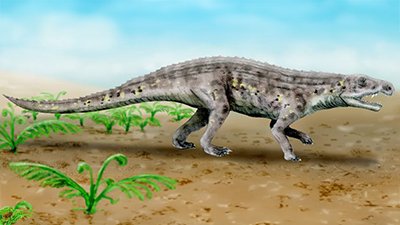
Is Jurassic World Wrong for Portraying Dinosaurs without Feathers?
Fans of the Jurassic Park trilogy have been eagerly awaiting the release of a fourth movie, Jurassic World. This highly anticipated sci-fi film is set to be released in the US on June 12, 2015. Recently a trailer for the movie was released that has created a big buzz in the media. Reportedly, the film is going to be a “big disappointment” to dinosaur fans because “unlike the 1993 original, which was praised for its attention to detail and accuracy, the new film shows portrays [sic] its Tyrannosaurus Rex and velociraptors all wrong.” One paleontologist made this comment: “The original film showed dinosaurs that were not simply roaring, scaly monsters but were active, social, bird-like animals with dynamic bodies. Now, Jurassic World is simply a dumb monster movie and there has been a deliberate effort to make its animals look different from the way we think they should.” Apparently the problem with Jurassic World is that the dinosaurs—including T. rex and velociraptor—lack feathers, and therefore the movie is supposedly completely inaccurate.
Did Dinosaurs Have Feathers?
Many scientists today have accepted the idea that dozens of different species of dinosaurs were covered in feathers. This has resulted in recent artist’s depictions showing dinosaurs covered in soft down or even flight-like feathers. These depictions are nothing short of bizarre and leave the dinosaurs looking quite ridiculous. But was Jurassic World wrong in leaving off the feathers and opting instead for the traditional scaly bodies?
Fibrous filaments with bristles are a far cry from the complex structure of a feather!
Feathers are highly complex structures that grow out of skin follicles, like human hairs. Scales, the traditional covering of dinosaurs, are folds in the skin. However, scientists now claim that many—if not most—dinosaurs had the ability to grow feathers. But the supposed evidence for feathered dinosaurs is scanty and speculative. Some dinosaur fossils have been uncovered that contain fibrous filaments. These filaments do not contain the same elements as feathers—shafts, barbs, or barbules—but instead merely have bristles. Fibrous filaments with bristles are a far cry from the complex structure of a feather! Despite the artistic license taken by many dinosaur sculptors and artists today, there is no conclusive evidence that any dinosaur had feathers.
Why are so many scientists eager to accept the idea of feathered terror, like T. rex, if the evidence is so speculative and controversial? Well, this easy acceptance with so little supporting evidence highlights that this is a worldview battle. Evolutionists firmly believe that modern birds are the descendants of dinosaurs. This is such a firm belief that many dinosaurs are referred to as “non-avian dinosaurs” and birds are called “avian dinosaurs.” Some scientists will go as far as to say that dinosaurs are not extinct, they are alive today all over the world twittering on telephone wires, eating at our bird feeders, and flying in flocks above our heads. The desperate desire for evidence to substantiate this idea is so strong that many evolutionary scientists eagerly jumped on the feathery dinos bandwagon despite the lack of evidence! Really, it is an evolutionary worldview that drives this acceptance and continued promotion of the idea.
Did Dinosaurs Evolve into Birds?
In a biblical worldview, birds would have actually been around before dinosaurs ever walked the Earth—a whole day before!
According to evolutionary thinking, modern birds are descendants of dinosaurs. But the biblical worldview stands in sharp contrast to this. According to God’s Word, birds were created fully formed and functioning to reproduce after their own kind on Day Five of Creation Week. Dinosaurs, which are land animals, would not have been created until Day Six. So in a biblical worldview, birds would have actually been around before dinosaurs ever walked the Earth—a whole day before!
Is there any compelling evidence that dinosaurs evolved into birds? Not at all! Dinosaurs were reptiles and share traits common among reptiles—not birds. They were likely cold-blooded, had lungs like other reptiles, and were covered in scales. Birds, on the other hand, are warm-blooded, have unique lungs, hollow bones, and are covered in feathers. They are completely and utterly different. Adding to the problems with evolutionary ideas about bird evolution is the fact that modern birds like parrots, loons, and owls are found in the fossil record in some of the very same layers as dinosaurs. How could modern birds have evolved from dinosaurs when modern, fully formed birds are found alongside dinosaurs in the very same layers?1
Did dinosaurs have feathers? In a biblical worldview, we do not expect to find feathered dinosaurs. Currently the evidence does not support the idea that dinosaurs were covered in feathers. Now while we may not know for sure what dinosaurs looked like, what we do know is that birds did not evolve from dinosaurs. They—like dinosaurs—were specially created by God in the beginning to reproduce according to their kind.
Footnotes
- Don Batten, “Modern Birds Found with Dinosaurs: Are Museums Misleading the Public?,” Creation Ministries International, accessed June 2, 2015, http://creation.com/modern-birds-with-dinosaurs.
Recommended Resources

Answers in Genesis is an apologetics ministry, dedicated to helping Christians defend their faith and proclaim the good news of Jesus Christ.
- Customer Service 800.778.3390
- © 2024 Answers in Genesis








